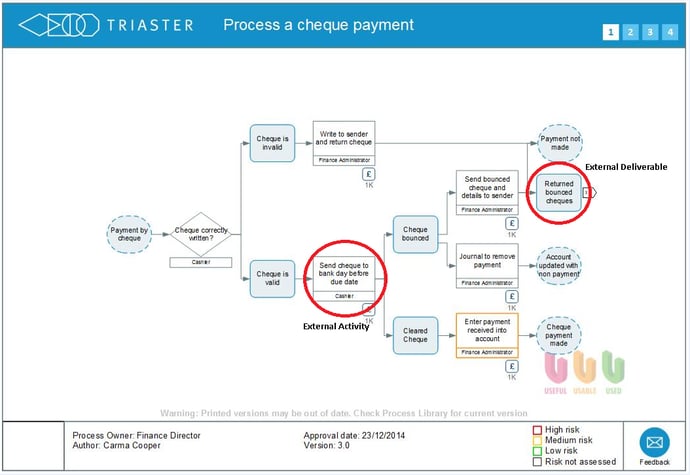Process Mapping symbols are more than just shapes, they are the key to creating consistent, useful process maps that their intended audience can understand. In this article I examine the 'Triaster traditional' symbols used in Triaster's free Process Mapping software - and why there is more to them than first appears...
Contents:
- The Importance of a Process Mapping Symbol Set
- Process Mapping Symbols Explained
- Process Mapping For Free
The Importance of a Process Mapping Symbol Set
With process mapping symbols, less is more. The more symbols you use, the less consistent your process maps become. This is particularly true if there are several process mappers - with a lot of symbols available, each mapper often uses slightly different ones and the resulting process maps are inconsistent and confusing to their intended end users.
Recognising this, Triaster's traditional set of process mapping symbols are limited in number, but have enormous power to capture and convey information.
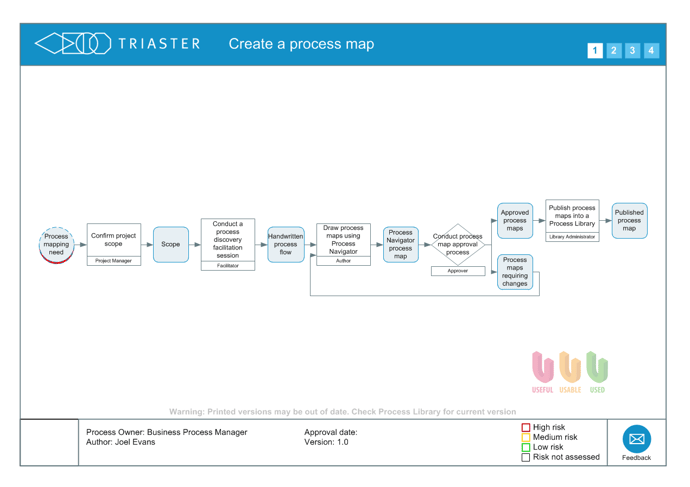
Process Mapping Symbols Explained
Triaster's developed the Process Navigator symbol set alongside our Noun-Verb process mapping methodology. The Noun-Verb method perfectly balances out the need for simple, comprehensible process diagrams which are also sufficiently detailed to enable the identification and analysis of performance improvement opportunities - and the following symbol set is an important part of this.
Activity
An ‘Activity’ symbol is used to describe something you do.
Activities are the steps of the process and are described using verbs. For example, ‘Update sales order with customer number’.
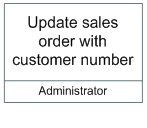 This is a deceptively simple shape, as it enables you to store behind it attributes relating to the work people perform such as:
This is a deceptively simple shape, as it enables you to store behind it attributes relating to the work people perform such as:
- Responsibility
- Accountability
- Time
- Effort etc.
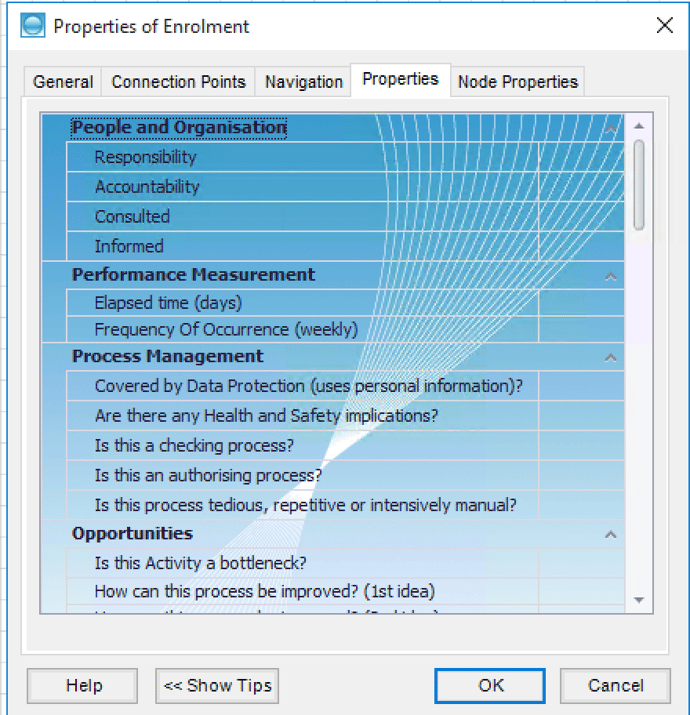
These properties enable the capture of detailed data relating to each activity, enabling complex analysis, but keeping the process map, uncluttered and easy to understand.
The image above shows the standard properties, but they can be customised.
Connectors
Connectors are simple arrows that connect 2 or more symbols together to show the direction of the process.

Decision
‘Decision’ symbols are a type of activity, usually in the form of a question, where only one of the outputs is produced.
For example, ‘Internal or external customer?’ may then branch into two different process pathways depending on which option is selected.
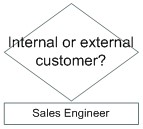
Deliverable
A ‘Deliverable’ symbol is used to describe something you produce and are the outputs of a process.
Deliverables are the items produced (or ‘delivered’) when each step of the process is complete and are described using nouns.

Deliverables therefore explicitly identify the benefit of doing the work (the activity). Without this shape the value delivered by a process will not be obvious to the end user of the process map. This is a key shape for the Noun-Verb process mapping methodology.
As deliverables typically relate to information sources in the organisation, this shape enables process mappers to capture the applications used to produce or store the output - the location of the template to produce it etc. - as properties behind the shape (like the activity symbol). The properties can be customised as required however.
External Activity
An external activity is used to highlight something that is done outside of the organisation but still needs to be shown in a process. External activities are described using verbs and transform their Inputs to Outputs.
An example might be the printing of a company newsletter by an external printing company.
External Deliverable
Off-Page Connectors
Off-page connectors are useful for overcoming the practical limitation of page sizes. It allows the process mapper to produce a logical, large ‘piece of paper’ containing a single end-to-end process map with all the Deliverables (outputs to inputs) linked directly to each other.
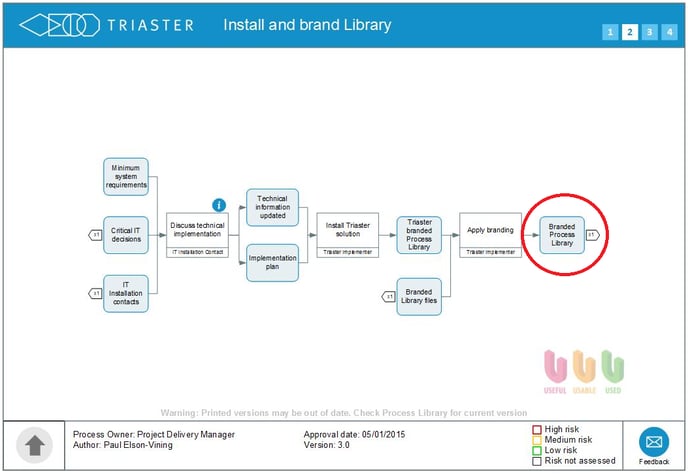
Start/End Deliverable
A start/end deliverable is a deliverable symbol that is used to signify the input at the very start or the output at the very end of a process, and shows that there are no additional steps relating to that input or output.
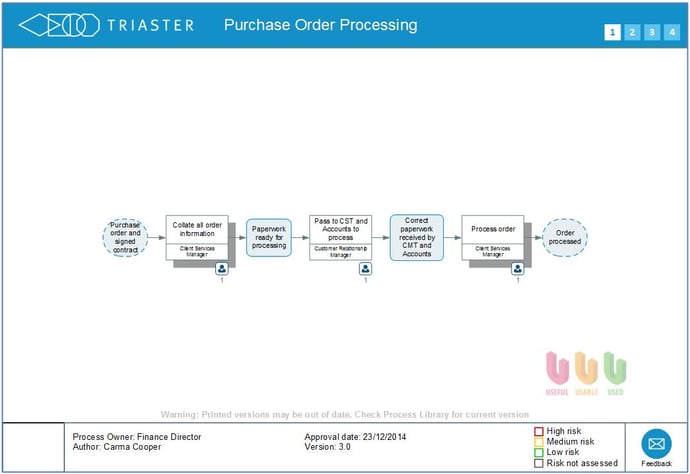
Process Mapping For Free
The symbols discussed in this article are the 'Triaster traditional' symbol set included with Triaster's free process mapping software, Process Navigator. (All Microsoft Visio symbol sets can be used however, including BPMN, IDEFO, Basic Flowchart... and Triaster custom.)
Triaster's symbol set has been developed - whilst working in the process mapping (and Business Process Management) space for over 25 years - alongside the Noun-Verb process mapping methodology, and has been used in many thousands of organisations. It has a proven track record of enabling the creation of clear, understandable process maps which the whole (non-specialist) organisation can and does use, whilst also supporting the collection of the detailed data required by business analysts and process improvement specialists.
Whatever your requirements are for a process mapping toolset, download Process Navigator now.
Related Articles:
How To Process Map For Free with Process Navigator
3 Common Business Process Mapping Mistakes (and How to Avoid Them)
Noun-Verb: A Simple Process Mapping Methodology
Related White Papers:
The Ultimate Guide to Business Process Mapping
This is an updated and refreshed edition of an article originally written in 2018.
Written by Michael Cousins
Mike founded Triaster in 1994. A thought leader in business improvement, he has led Triaster ever since, spearheading its development of beautifully engineered business improvement software, that is both full of the functionality required by business analysts and that end users find really easy to use.

